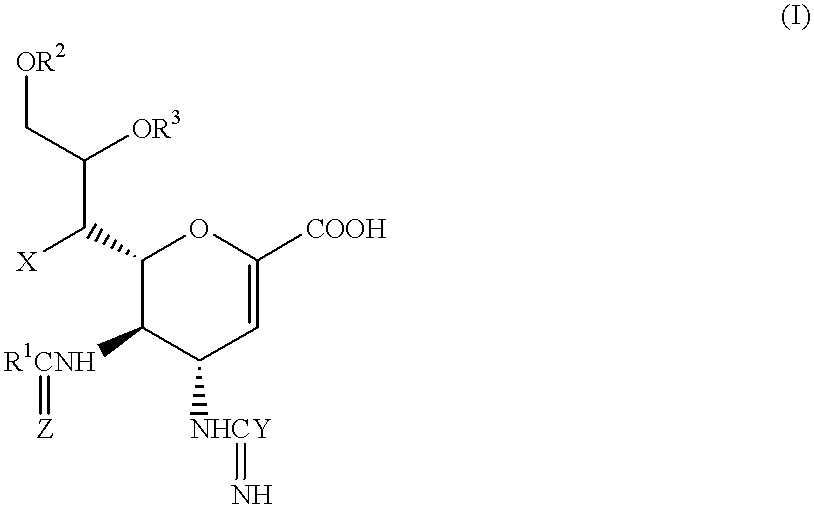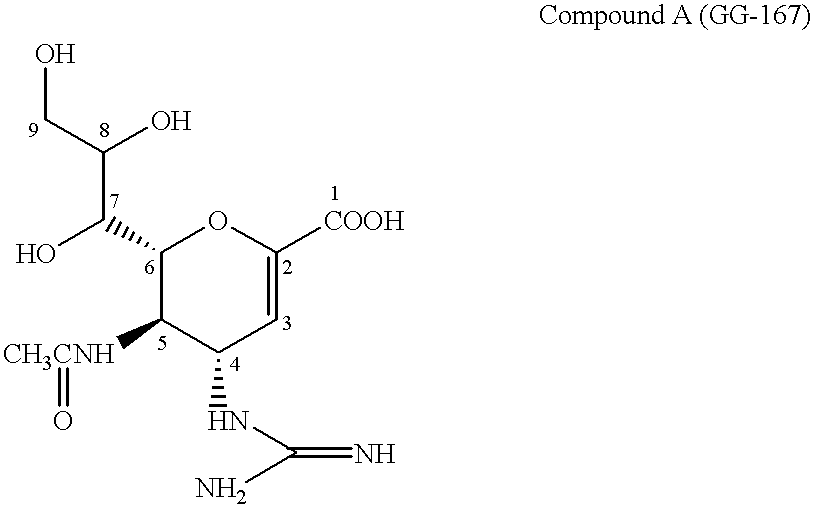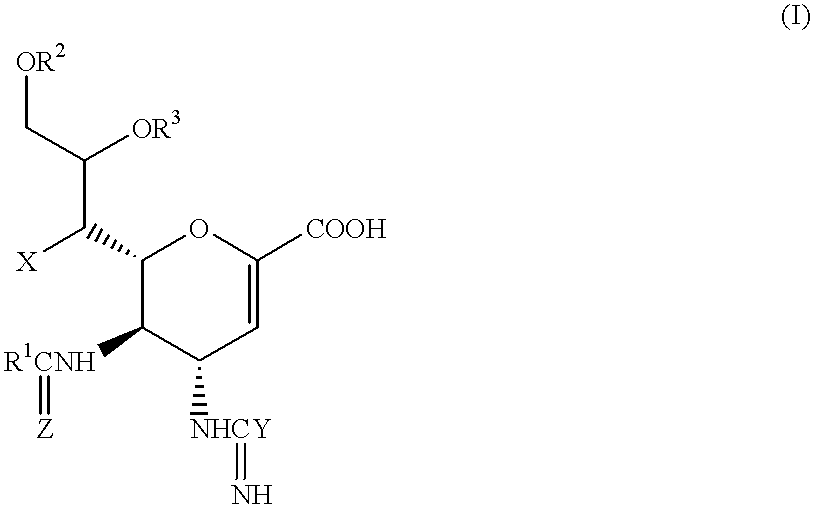Neuraminic acid derivatives, their preparation and their medical use
a technology of neuronal acid and derivatives, applied in the field of neuronal acid, can solve the problem of second-infection of surrounding cells
- Summary
- Abstract
- Description
- Claims
- Application Information
AI Technical Summary
Benefits of technology
Problems solved by technology
Method used
Image
Examples
example 12
4-Guanidino-9-O-tetradecanoyl-5-thioacetamido-2,3,4,5-tetradeoxy-D-glycero--D-galacto-non-2-enopyranosoic Acid Trifluoroacetic Acid Salt (Compound No. 31-41)
[1400] 29
[1401] 12(i) Methyl 4-(N,N'-bis-t-butoxycarbonylguanidino)-7-tetradecanoyl--8,9-O-isopropylidene-5-thioacetamido-2,3,4,5-tetradeoxy-D-glycero-D)-gala-cto-non-2-enopyranosoate
[1402] 440 mg (0.73 mmol) of methyl 5-thioacetamido-4-(N,N'-bis-t-butoxyca-rbonylguanidino)-8,9-O-isopropylidene-2,3,4,5-tetradeoxy-D-glycero-D-galac-to-non-2-enopyranosoate [prepared as described in Example 9(i)] were dissolved in 15 ml of methylene chloride, and 132 mg (1.08 mmol) of dimethylaminopyridine and 247 mg (1.0 mmol) of tetradecanoyl chloride were added to the resulting solution. The mixture was then stirred at room temperature for 30 minutes, after which 109 mg (1.08 mmol) of triethylamine were added, and the mixture was stirred for 15 hours. The reaction mixture was then poured into a 2-layer solution of 30 ml of ethyl acetate and 15 m...
example 13
5-Acetamido-4-guanidino-9-O-hexanoyl-2,3,4,5,7-pentadeoxy-7-fluoro-D-glyce-ro-D-galacto-non-2-enopyranosoic Acid Trifluoroacetic Acid Salt (Compound No. 1-36)
[1462] 30
[1463] 13(i) Diphenylmethyl 5-acetamido-4-(N,N'-bis-t-butoxycarbonylguanid-ino)-2,3,4,5,7-pentadeoxy-7-fluoro-D-glycero-D-galacto-non-2-enopyranosoat-e
[1464] 100 mg (0.24 mmol) of methyl 5-acetamido-4-(N,N'-bis-t-butoxycarbon-ylguanidino)-8,9-di-O-acetyl-2,3,4,5,7-pentadeoxy-7-fluoro-D-glycero-D-gal-acto-non-2-enopyranosoate [prepared as described in Example 6(ii)] were dissolved in 3 ml of methanol, and 0.5 ml of a 0.1 N methanolic solution of sodium methoxide was added to the resulting solution. The mixture was then stirred at room temperature for 1 hour, after which the reaction mixture was neutralized with a 4 M solution of hydrogen chloride in dioxane, and the solvent was removed by distillation under reduced pressure. The resulting residue was dissolved in 1 ml of distilled water and 280 ml of a 1 N aqueous solut...
example 14
5-Acetamido-4-guanidino-9-O-octanoyl-2,3,4,5,7-pentadeoxy-7-fluoro-D-glyce-ro-D-galacto-non-2-enopyranosoic Acid Trifluoroacetic Acid Salt (Compound No. 1-38)
[1515] 31
[1516] 14(i) Diphenylmethyl 5-acetamido-4-(N,N'-bis-t-butoxycarbonylguanid-ino)-9-O-octanoyl-2,3,4,5,7-pentadeoxy-7-fluoro-D-glycero-D-galacto-non-2--enopyranosoate
[1517] 50 mg (0.072 mmol) of diphenylmethyl 5-acetamido-4-(N,N'-bis-t-buto-xycarbonylguanidino)-2,3,4,5,7-pentadeoxy-7-fluoro-D-glycero-D-galacto-non--2-enopyranosoate [prepared as described in Example 13(i)] were dissolved in 2 ml methylene chloride, and 11 mg (0.11 mmol) of triethylamine and 16 mg (0.086 mmol) of octanoyl chloride were added to the resulting solution, whilst ice-cooling. The mixture was then stirred at 0.degree. C. for 1 hour. At the end of this time, the reaction mixture was poured into a 2-layer solution of 5 ml of ethyl acetate and 3 ml of a saturated aqueous solution of sodium hydrogencarbonate, and the organic layer was separated and ...
PUM
| Property | Measurement | Unit |
|---|---|---|
| temperature | aaaaa | aaaaa |
| temperature | aaaaa | aaaaa |
| temperature | aaaaa | aaaaa |
Abstract
Description
Claims
Application Information
 Login to View More
Login to View More - R&D
- Intellectual Property
- Life Sciences
- Materials
- Tech Scout
- Unparalleled Data Quality
- Higher Quality Content
- 60% Fewer Hallucinations
Browse by: Latest US Patents, China's latest patents, Technical Efficacy Thesaurus, Application Domain, Technology Topic, Popular Technical Reports.
© 2025 PatSnap. All rights reserved.Legal|Privacy policy|Modern Slavery Act Transparency Statement|Sitemap|About US| Contact US: help@patsnap.com



